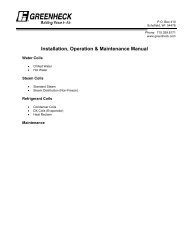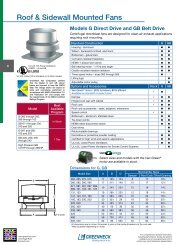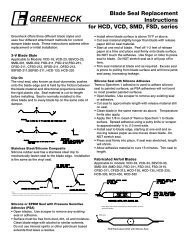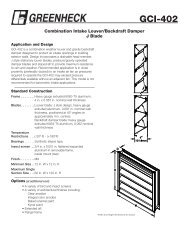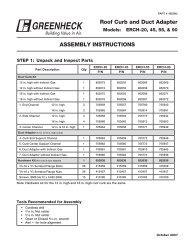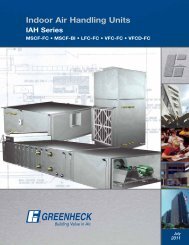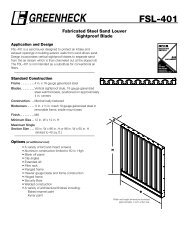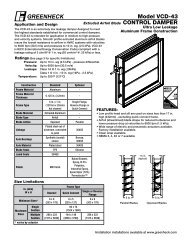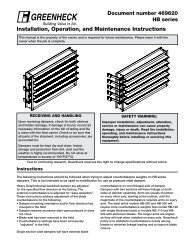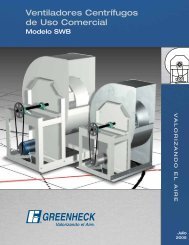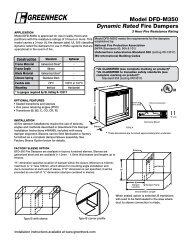7800 series relay modules - Greenheck
7800 series relay modules - Greenheck
7800 series relay modules - Greenheck
Create successful ePaper yourself
Turn your PDF publications into a flip-book with our unique Google optimized e-Paper software.
RM7895A,B,C,D/EC7895A,C; RM7896A,B,C,D <strong>7800</strong> SERIES RELAY MODULES<br />
4. PILOT FLAME ESTABLISHING PERIOD (PFEP)<br />
a. Airflow lockout feature is enabled and the airflow<br />
switch does not close after ten seconds or within<br />
the specified purge card timing.<br />
b. Flame signal is detected after 30 seconds.<br />
c. Ignition/pilot valve/intermittent pilot valve terminal<br />
is energized.<br />
d. Main valve terminal is energized.<br />
e. Delayed (2nd stage) main valve terminal is<br />
energized (RM7895C,D/EC7895C; RM7896C,D).<br />
f. Internal system fault occurred.<br />
g. Purge card is removed.<br />
h. Purge card is bad.<br />
5. MAIN FLAME ESTABLISHING PERIOD (MFEP)<br />
(RM7895C,D/EC7895C; RM7896C,D)<br />
a. Airflow lockout feature is enabled and the airflow<br />
switch opens.<br />
b. Ignition terminal is energized.<br />
c. Ignition/pilot valve terminal is not energized.<br />
d. Main valve terminal is not energized.<br />
e. Delayed main valve terminal is energized.<br />
f. No flame present at end of MFEP.<br />
g. Internal system fault occurred.<br />
h. Purge card is removed.<br />
i. Purge card is bad.<br />
6. RUN PERIOD<br />
a. No flame present.<br />
b. Airflow lockout feature is enabled and the airflow<br />
switch opens.<br />
c. Interrupted pilot valve terminal is energized<br />
(RM7895C,D/EC7895C; RM7896C,D).<br />
d. Main valve terminal is not energized.<br />
e. Delayed (2nd stage) main valve terminal is not<br />
energized (RM7895C,D/EC7895C; RM7896C,D).<br />
f. Internal system fault occurred.<br />
g. Purge card is removed.<br />
h. Purge card is bad.<br />
OPERATION<br />
Sequence of Operation<br />
The RM7895A,B,C,D/EC7895A,C; RM7896A,B,C,D has the<br />
operating sequences listed below; see Fig. 2 and 3. The<br />
RM7895A,B,C,D/EC7895A,C; RM7896A,B,C,D LED provide<br />
positive visual indication of the program sequence: POWER,<br />
PILOT, FLAME, MAIN and ALARM.<br />
Initiate<br />
The RM7895A,B,C,D/EC7895A,C; RM7896A,B,C,D Relay<br />
Module enters the INITIATE sequence when the <strong>relay</strong> module<br />
is powered. The RM7895A,B,C,D/EC7895A,C;<br />
RM7896A,B,C,D can also enter the INITIATE sequence if the<br />
<strong>relay</strong> module verifies voltage fluctuations of +10/-15% or<br />
frequency fluctuations of ±10% during any part of the<br />
operating sequence. The INITIATE sequence lasts for ten<br />
seconds unless the voltage or frequency tolerances are not<br />
met. When not met, a hold condition is initiated and displayed<br />
on the optional KDM for at least five seconds; when met, the<br />
INITIATE sequence restarts. If the condition is not corrected<br />
and the hold condition exists for four minutes, the<br />
RM7895A,B,C,D/EC7895A,C; RM7896A,B,C,D locks out.<br />
Causes for hold conditions in the INITIATE sequence:<br />
a. AC line dropout detection.<br />
b. AC line noise that can prevent a sufficient reading of<br />
the line voltage inputs.<br />
c. Low line voltage brownouts.<br />
The INITIATE sequence also delays the burner motor starter<br />
from being energized and de-energized from an intermittent<br />
AC line input or control input.<br />
Standby<br />
The RM7895A,B,C,D/EC7895A,C; RM7896A,B,C,D is ready<br />
to start an operating sequence when the operating control<br />
input determines a call for heat is present. The burner switch,<br />
limits, operating limit control and all microcomputer-monitored<br />
circuits must be in the correct state for the <strong>relay</strong> module to<br />
continue into the PREPURGE sequence.<br />
Normal Start-Up Prepurge<br />
The RM7895A,B,C,D/EC7895A,C; RM7896A,B,C,D Relay<br />
Module provides PREPURGE timing selectable from two<br />
seconds to thirty minutes with power applied and the<br />
operating control indicating a call for heat.<br />
1. The Airflow Interlock, burner switch, Run/Test switch<br />
and all microcomputer-monitored circuits must also be<br />
in the correct operating state.<br />
2. The motor output, terminal 4, is powered to start the<br />
PREPURGE sequence.<br />
3. The Airflow Interlock input closes ten seconds into<br />
PREPURGE or within the specified purge card timing;<br />
otherwise, a recycle to the beginning of PREPURGE or<br />
lockout occurs, depending on how the Airflow Switch<br />
selectable jumper (JR3) is configured.<br />
Ignition Trials<br />
1. Pilot Flame Establishing Period (PFEP):<br />
a. When the PFEP begins:<br />
(1) The pilot valve and ignition transformer,<br />
terminals 8 and 10, are energized. The<br />
RM7895A,B, EC7895A, and RM7896A,B have<br />
an intermittent pilot valve, terminal 8. The<br />
RM7895C,D, EC7895C, and RM7896C,D<br />
have an interrupted pilot valve, terminal 8.<br />
(2) Flame must be proven by the end of the ten<br />
second PFEP (four seconds if Configuration<br />
Jumper JR1 is clipped) to allow the sequence<br />
to continue. If a flame is not proven by the end<br />
of PFEP, a safety shutdown occurs.<br />
b. With flame proven, the ignition, terminal 10, is deenergized.<br />
2. Main Flame Establishing Period (MFEP):<br />
a. After the Ignition Trials, and with the presence of<br />
flame, the main fuel valve, terminal 9, is powered.<br />
If a flameout occurs, the <strong>relay</strong> module locks out or<br />
recycles (depending on status of jumper JR2)<br />
within 0.8 or 3 seconds, depending on the Flame<br />
Failure Response Time (FFRT) of the amplifier.<br />
b. The RM7895C,D/EC7895C, and RM7896C,D have<br />
a ten second MFEP. After the Ignition Trials and<br />
with the presence of flame, the main fuel valve,<br />
terminal 9, is powered. If a flameout occurs, the<br />
<strong>relay</strong> module locks out within 0.8 or 3 seconds,<br />
depending on the amplifier FFRT.<br />
11 66-1090—2




